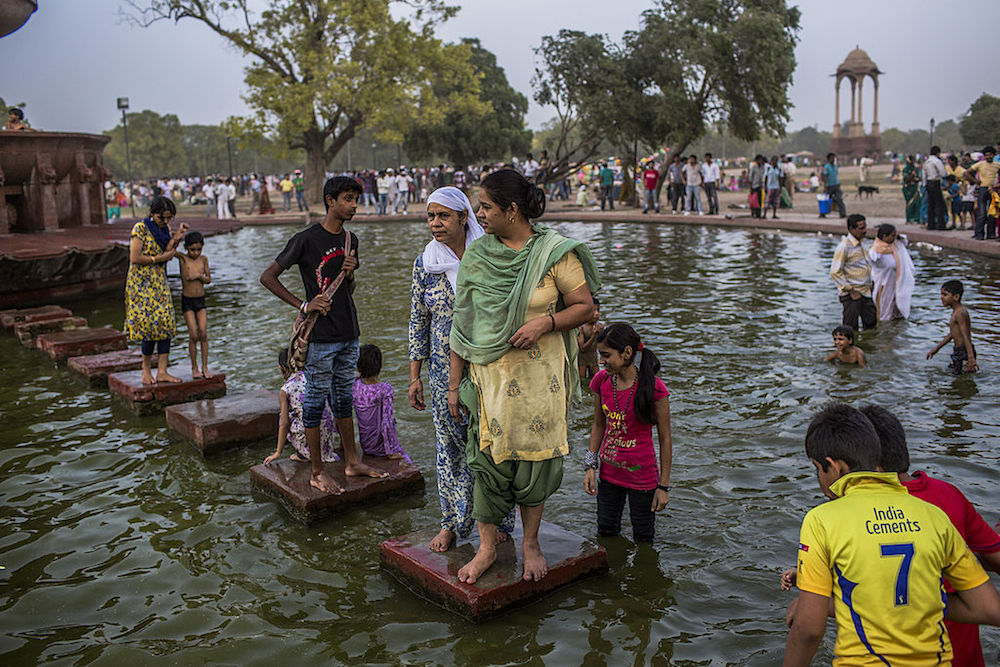When you purchase through links on our land site , we may pull in an affiliate mission . Here ’s how it go .
By the end of this hundred , temperatures in South Asia — a area where about one - fifth of the existence ’s universe go — could become too red-hot and humid for mass to live , according to a Modern study .
Climate alteration in Pakistan , Nepal , India , Bangladesh and Sri Lanka could be so grievous by the later 21st hundred that temperature and humidity may exceed the upper levels of human survivability , scientists report in a study publish online Aug. 2 in thejournal Science Advances . The hazard posed by such extreme conditions over a crescent - shaped area where 1.5 billion people survive could have disastrous effects , the authors write . [ The 8 Hottest Places on Earth ]

Families cool off in a pond during a heat wave on 25 December 2024, in New Delhi, India.
" Most of these people bank on agriculture , and so they have to spend clip open air that exposes them to instinctive temperature , " said the study ’s principal investigator , Elfatih Eltahir , a prof of civil and environmental technology at the Massachusetts Institute of Technology .
These three factors — extremely high temperatures , one C of billion of pitiful people and the reality of having to work outside — mix to limit a very discriminating level of exposure , Eltahir differentiate Live Science . " That convergence is what we are bringing attention to , " he said .
Just two year ago , the fifthdeadliest heat wavein recorded chronicle swept over heavy parts of India and Pakistan and claimed about 3,500 lives , the researchers write in the subject area .

The research worker used the best available data on clime that identifies variations in terrain and vegetation down to 10 square miles ( 25 square kilometers ) and feed it into global circulation models to producedetailed estimator simulations . The resulting predictions showed extremum in so - name loaded - medulla temperaturesin South Asia ( abbreviated as TW ) .
TW , first key out in a 2010 work published in thejournal Proceedings of the National Academy of Sciences , is a combined measure of temperature and humidness . Wet - light bulb temperatures hotter than 95 degrees Fahrenheit ( 35 degree Celsius ) — about the same temperature as human skin under ardent condition — make it impossible for the body to dissipate heat naturally .
" Human exposure to TW of around 35 degrees C for even a few hours will lead in death even for the fittest of humanity under shaded , well - ventilated term , " the investigator wrote .

Although slopped - lightbulb temperatures today typically do not go over88 academic degree Fahrenheit(31 degree C ) , they virtually reached the threshold of 95 degrees Fahrenheit ( 35 level C ) in the summer of 2015 , when anextreme warmth wavehit Bandar Mahshahr , Iran , and component of the Persian / Arabian Gulf , the source spell . In old research , Eltahir and his colleagues predicted that this region , nigh and around the Persian / Arabian Gulf , would see some of the hottest wet - medulla temperature in the world .
Although the hazard is high in this part of the Middle East , the part ’s exposure to such gamy temperature is gloomy than in South Asia , Eltahir said . The hottest regions would pass mainly over the ocean . What ’s more , not very much of the land in and around the surface area of the Persian Gulf and Arabian Peninsula is devoted to agriculture , fewer people dwell in this region than in South Asia , and they tend to be moneyed , he said .
But pixilated - bulb temperatures could pass the threshold in parts of northeastern India and most of Bangladesh during seasonal heating waves by the ending of this century , the researcher said . In this latest study , the computing machine models predicted that the second - hot cockeyed - incandescent lamp temperatures would occur in South Asia . These scorching condition would occur over ground , where one - fifth of the world ’s population lives and where many more people are vulnerable because they are poor and work outside . When the 2015 heating system wave hit India and Pakistan , it claimed the sprightliness of 3,500 the great unwashed .

" We think it ’s crucial for mass to realize and appreciate what clime change can bring to their aliveness , " Eltahir said .
Original clause onLive Science .















